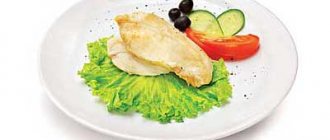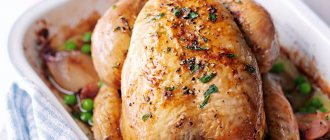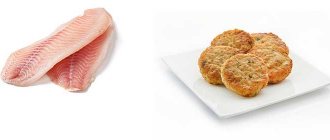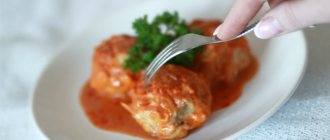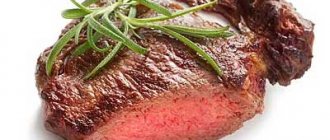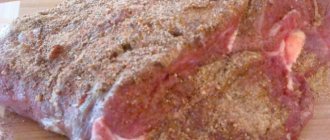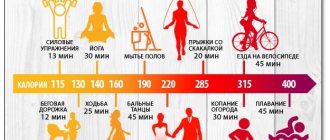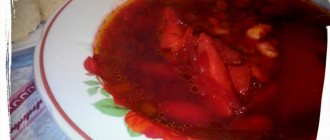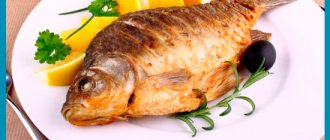Related Products
Chicken Breast (184 cal) Steamed Chicken (175 cal) Cooked Chicken (237 cal) Chicken Breast (150 cal) Boiled Chicken (215 cal) Chicken Leg (233 cal) Chicken Wings (241 cal) White chicken meat (188 kcal.) Chicken fillet (150 kcal.) Skinless chicken (150 kcal.) Chicken cutlet (290 kcal.) Chicken steak (239 kcal.) Grilled chicken (193 kcal.) Chicken meat (181 kcal.) ) Butter Fried Chicken (284 cal) Rotisserie Chicken (150 cal) Chicken Thigh (226 cal) Whole Fried Chicken (227 cal) Lean Chicken (143 cal) Skin-On Chicken (234 cal) Sauté chicken (217 cal) Chicken skin (423 cal) Canned chicken (155 cal) Chicken gizzard (154 cal) Minced chicken (189 cal) Chicken heart (185 cal) Chicken liver (170 cal) Stewed chicken (210 cal) Raw Chicken (172 cal) Chicken Giblets (191 cal) Chicken Leg (188 cal) Whole Chicken (239 cal)
Culinary improvisation
You can prepare dozens of different dishes from chicken meat. Meat goes perfectly with vegetables, mushrooms, sauces and cheese. We invite you to prepare a complete, satisfying and nutritious dish. Vegetables will serve as a side dish, and cheese will add amazing creamy notes of flavor. You can use absolutely any part of the chicken, but it is better to give preference to breast or fillet.
Ingredients:
- fresh frozen chicken breast – one piece;
- Russian cheese – 200 g;
- zucchini - two pieces;
- onion - one head;
- store-bought mustard - one teaspoon. spoon;
- mayonnaise sauce – 100 ml;
- fresh champignons – 500 g;
- refined vegetable oil – two tablespoons. spoons;
- fresh tomatoes - two pieces;
- potatoes - four tubers.
Preparation:
- We prepare products according to the list. It is advisable to take chicken breast chilled and without skin. Wash the mushrooms thoroughly and dry.
- We clean and wash the vegetables.
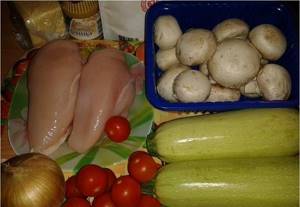
- Remove the film from the chicken fillet, wash it and dry it with a napkin. Cut into small pieces.
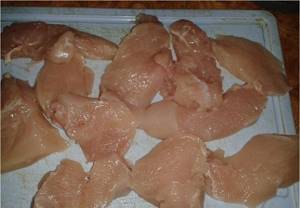
- Lightly beat each piece of fillet.

- In a bowl, mix mayonnaise sauce with a minimum percentage of fat content and store-bought mustard.
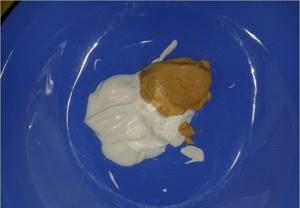
- Season the chicken breast with this mixture and stir. Leave to marinate for some time.
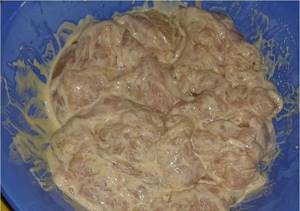
- Cut the potatoes into slices.
- Grind young zucchini into medium-thick slices.
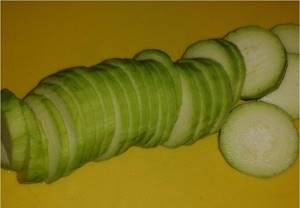
- Cut the tomatoes into slices. If you took Cherry tomatoes, just cut them in half.

- Grind the champignons into plates.
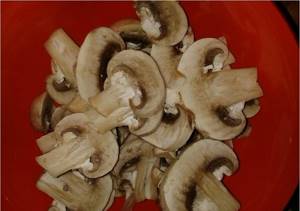
- Chop the onion in the shape of half rings.
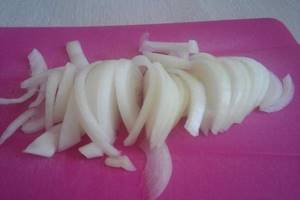
- Grease the refractory mold with refined vegetable oil. We make a pillow out of potatoes, on top of which we lay pieces of chicken breast.
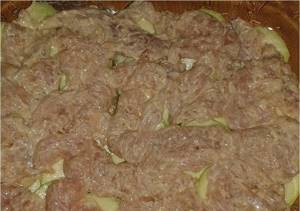
- The next layer is zucchini.
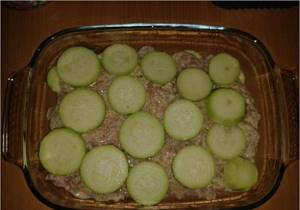
- Next come the mushrooms. There is no need to pre-heat the champignons.

- Spread the onions on top.
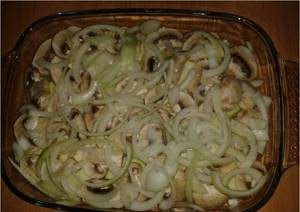
- The final touch is fresh tomatoes.
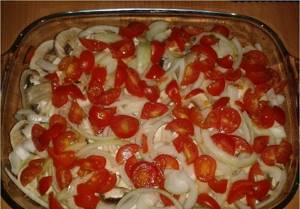
- You can make a mesh out of mayonnaise sauce so that all the components of the dish are soaked during the baking process.
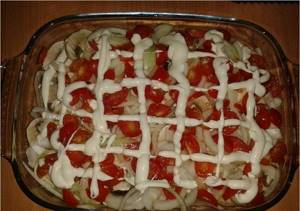
- Cover the pan tightly with aluminum foil and place in the oven.
- Set the temperature at 200°.
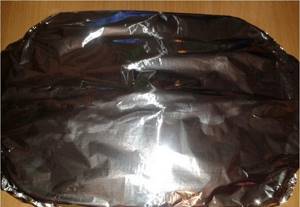
- After one hour, take out the dish and sprinkle grated Russian cheese on top.
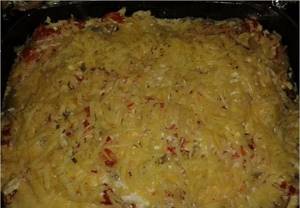
- Continue baking until the cheese is completely melted and takes on an amber hue.
Composition of nutrients, BJU
Baked chicken
| For quantity: 100 grams | ||
| Calories — 150 | Calories from fat - 30 | |
| BJU | ||
| Total fat content | 3.28g | |
| Saturated | 1g | |
| Polyunsaturated | 0.74g | |
| Monounsaturated | 1.27g | |
| Cholesterol | 105mg | |
| Total carbohydrate content | 0g | |
| Dietary fiber | 0g | |
| Sugar | 0g | |
| Squirrels | 30.02 | |
| Vitamins and microelements | ||
| A - 10 µg | C - 0mg | |
| B-6 – 1.07 mg | B-12 - 0.2 µg | |
| D - 0mcg | E - 0.44 mg | |
| Calcium 6mcg | Iron 0.44 mg | |
| Magnesium 32.5 mg | Zinc 0.86mg | |
| Potassium 406 mg | Sodium 134 mg | |
Distribution of calories for BJU:Carbohydrates (1%) Fats (19%) Proteins (80%) | ||
Dietary properties:
How many calories are in oven-baked chicken, what dietary properties it has, all this is of great interest to those who lead a healthy lifestyle and monitor their health and figure. So we will try to answer these questions in the next article.
So:
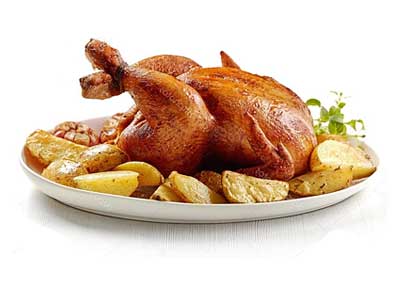
It has been proven that in terms of protein content, chicken meat is ahead of beef and even lean pork. Chicken contains more polyunsaturated fatty acids than other types of meat. This makes it not only an easily digestible food product, but also makes chicken meat useful for the prevention of coronary disease, myocardial infarction, stroke, and hypertension. This feature helps normalize metabolism and strengthen immune defense.
A heavy dose of various vitamins also helps make our body less susceptible to disease.
Chicken meat is a rich source of vitamin B2 (affects all types of metabolic processes, is involved in the management of carbohydrate and fat metabolism, ensures the normal functioning of our central nervous system, is “responsible” for the health of the skin and nails), vitamin B6 (important for the implementation of protein and fat metabolic processes, improves the nervous system, as well as the skin), vitamin B9 (necessary for normal hematopoiesis, necessary for the regulation of protein metabolism, increases the body’s resistance to external negative factors, and is also necessary for a successful pregnancy), vitamin B12 (increases immunity, leads to normal blood pressure, is important for the health of the reproductive system, prevents depression and insomnia).
To preserve all the beneficial properties of chicken meat, it is best to bake it.
The benefits and harms of chicken
Nutritionists recommend consuming domestic chicken, since artificially bred birds are often raised with hormones and treated with antibiotics. Among all the methods of preparing chicken, preference is best given to boiling, steaming, stewing or baking, but in no case frying. The fact is that during frying, protein molecules are damaged, the amount of fat increases, and carcinogens are released.

Photo source: shutterstock.com
It is also not recommended to eat smoked chicken, since, in addition to natural smoking, there is another way to obtain this tasty meat - chemical processing, during which phenols and carcinogens are formed.
It is important to remember that the most dangerous part of the chicken is the skin, as it acts as a kind of garbage can for birds. It is in it that toxins, metals and other harmful components present in polluted air accumulate. Therefore, the skin must be removed.
Recipe? Recipe!
Chicken with cranberries:
1 chicken carcass, 150 ml vegetable oil, 200 g cranberries, 20 g sugar, 20 g garlic (grated), 3 g ground red pepper, 3 g ground black pepper, salt.
Rinse the carcass. Sort the cranberries and wash them. Mix garlic with salt, red and black pepper. Rub the mixture over the chicken. Fill it with a mixture of cranberries and sugar, sew it up and place it on a baking sheet. Cook in an oven preheated to 180°C for 1 hour, periodically basting with vegetable oil.
How many calories are in boiled, fried, baked chicken?
As a result of heat treatment, the meat softens. The connective tissue that gives “stiffness” is partially gelatinized. Thanks to this, the meat is better digestible. When chicken is cooked, partial hydrolysis of proteins occurs, resulting in the formation of soluble compounds (peptides, amino acids). When cooked, these substances release into the broth (they form foam), and in fried chicken they remain on the surface of the piece.
Lipids are also partially destroyed. During cooking, their breakdown products are also extracted into the liquid, and when frying, they remain on the surface of the meat and in the frying pan. During heat treatment, there is a significant loss of vitamins and minerals due to transfer into the broth and due to irreversible decomposition. This is especially true for vitamin B1 (losses are 25-45%), B2 (15-40%), PP (15-20%).

It is worth noting that boiled chicken contains less minerals than fried chicken. This is due to large losses of biologically active substances when boiling meat in liquid. Some of the nutritional compounds that provide calories, as well as biologically active substances, remain in the broth.
Thus, the method of cooking chicken leaves its mark on the overall energy value of the dish and the biochemical composition. Adding butter, mayonnaise, flour, cooking with cheese, vegetables, mushrooms, rice, buckwheat and other products to some extent increases or, conversely, decreases the number of kilocalories. You can take the following figure as a starting point:
The calorie content of raw chicken meat is on average 180 kcal per 100 grams.
If we look at individual parts of chicken, due to different amounts of fat and quality of protein, they provide different amounts of calories when digested. The average data is displayed more clearly in the following list (the number of kilocalories is indicated per 100 g):
- Breast – 115
- Ham – 160-190
- Thigh – 190-210
- Wings – 180-190
- Stomachs – 110-120
- Liver – 130-140
- Hearts – 150-160
As for the calorie content of chicken eggs, it is discussed in detail in a separate article. There is data on the energy value of scrambled eggs from 2, 3 eggs, omelettes and other dietary dishes using eggs.
Calorie content of boiled chicken
The amount of protein in chicken after cooking is 25.2 g, lipids - 7.4, calcium - 36 mg, magnesium - 22 mg, phosphorus - 166 mg, iron - 2.2 mg, vitamin A - 0.04 mg, vitamin B1 – 0.04 mg, B2 – 0.12 mg, PP – 5.96 mg, C – 1.4 mg. These data are given per 100 grams of product.
Calorie content of boiled chicken without skin is 168 kcal per 100 g. Boiled chicken with skin is 215 kcal/100 g.
Boiled skinless chicken breast contains the lowest amount of calories compared to other parts of the carcass and compared to other cooking methods. It is boiled fillet (or steamed) that is the most dietary and healthy. The main thing is that it is without skin.
The meat of adult chickens and chickens, steamed or boiled in a small amount of water, is recommended to be included in the menu of strict fasting and therapeutic diets. If skinless meat is cooked in broth, then a large amount of purine bases, nitrogen-containing extractives, cholesterol, antibiotics, anabolic hormones, and essential oils goes into liquid. This explains why boiled chicken is useful in the diet of all age groups. The moderate calorie content of boiled chicken is a confirming factor in this regard.
How many calories are in baked chicken?
When baked in the oven, the calorie content of chicken is higher than that of boiled chicken. Even if the chicken is eaten baked in the oven without oil, its energy value is slightly higher. This is explained by the transformation of fats under the influence of high temperature and the preservation of nutrients that provide energy in the carcass.
The calorie content of baked chicken in the oven without oil is 238 kcal per 100 grams.
To improve the taste of meat, brush it with lemon juice or balsamic vinegar before baking. This, of course, does not reduce the calorie content, but it does help soften the fiber to some extent.
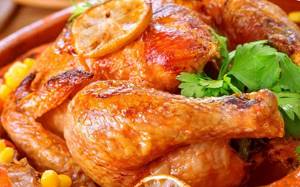
How many calories are in fried and grilled chicken?
The content of nutrients and biologically important substances in fried chicken meat is distributed as follows: proteins - 26.3 g, fats - 11 g, calcium - 33 mg, magnesium - 27 mg, phosphorus - 216 mg, iron - 2.5 mg, vitamin A - 0 .04 mg, B1 – 0.06 mg, B2 – 0.12 mg, PP – 7.42 mg, C – 1.2 mg,
Calorie content of fried chicken meat – 214 kcal/100 g.
For frying and preparing cutlets, chops, and meatballs, it is better to use the meat of young chickens. It is softer and more tender, so it cooks better. For this purpose, you can take fillet, drumstick or thigh.
Chicken kebab has similar calorie figures. The exact indicator depends in this case on the filling that is used for marinating.
The calorie content of chicken kebab in soy sauce is 225 kcal/100 g, in honey marinade – 235, in mayonnaise – 285.
A special item is smoked chicken. Before you say how many calories are in smoked chicken, it is worth recalling that modern smoking is not always a safe process from a health point of view. Artificial processing of the carcass with substances with a smoky smell fills the meat with harmful carcinogenic substances. This is one of the reasons for excluding smoked chicken from the diet.
The calorie content of smoked and grilled chicken is 250 kilocalories per 100 g.
How many calories are in chicken shawarma?
This popular fast food dish can be prepared in many ways. The dietary option includes a low-calorie kefir sauce. This shawarma with chicken and vegetables may not pose a threat to your figure, since its calorie content is low.
There are many recipes for dietary sauces instead of mayonnaise. They are used for salads and including shawarma. But most often in public catering outlets, lavash is filled with fried chicken, topped with mayonnaise and ketchup. This dish cannot be called dietary.
Calorie content of shawarma with chicken in pita bread without sauce is 80 kcal/100g. With low-calorie sauce – 115 kcal/100 g. With mayonnaise and ketchup – 180 kcal per 100 g.
Chicken meat in dietetics and for weight loss
Chicken is one of the best sources of protein
and is also suitable for any diet that requires a source of lean meat and protein. In particular, chicken fillet has beneficial properties. , are known to be effective in weight loss. Chicken is the main assistant in weight loss, since the meat provides high protein content. Studies and trials have shown that significant weight control has been observed in those people who eat chicken regularly.
Proteins in chicken meat help:
- muscle growth and development;
- maintain a healthy body weight;
- lose weight.
Composition and nutritional value of chicken
No type of meat contains as many important substances for the human body as chicken. It contains calcium, magnesium, phosphorus, potassium, iron, as well as valuable vitamins A, B1, B2, B2, B3, B5, B6, B9, C, E and a number of amino acids. But the most important thing is that it is a source of easily digestible protein, which activates the growth of muscle mass.
Useful properties of chicken meat:
- activation of muscle growth;
- strengthening nails and hair;
- acceleration of metabolic processes in the body;
- positive effect on the functioning of the reproductive organs;
- normalization of the nervous system, reduction of stress and anxiety levels;
- maintaining normal blood pressure.
How to burn calories from 100 g of baked chicken
For example, to burn all the calories from 100 grams of baked chicken, you will need 15 minutes of running or 3 hours and 1 minute of sleep.
>»> >»> >»> >»> >»> >»> >»> >»> >»> >»> >»> >»> >»> >»> >»>
| Activity | Calorie content per day per 100 g | |
| Dream | 3 h 01 min | 13% |
| Meditation | 2 hours 42 minutes | 11% |
| Rest | 2 hours 28 minutes | 10% |
| Reading books, Internet | 2 hours 05 minutes | 9% |
| Sex | 1 hour 18 minutes | 5% |
| Yoga, Pilates | 0h 51 min | 4% |
| Dancing | 0 h 48 min | 3% |
| Walking | 0 h 42 min | 3% |
| Football | 0 h 25 min | 2% |
| Swimming | 0 h 24 min | 2% |
| Abs workout | 0h 22 min | 2% |
| Power training | 0h 22 min | 2% |
| A ride on the bicycle | 0 h 20 min | 1% |
| Jumping rope | 0h 16 min | 1% |
| Run | 0 h 15 min | 1% |
Other parts of chicken
While chicken breast, thighs, wings and drumsticks are the most popular parts of chicken, there are also several others to choose from.
Here are the calorie content of some other parts of chicken (, , , ):
- Chicken strips (small breast muscles of chicken) : 263 calories per 100 grams.
- Chicken backs : 137 calories for every 100 grams.
- Dark meat : 125 calories for every 100 grams.
- Light meat : 114 calories for every 100 grams.
Summary:
The amount of calories in different parts of chicken varies. Light meat has the lowest amount of calories, while chicken strips have the highest level.
Chicken drumsticks: 76 calories
Chicken legs consist of two parts - thigh and drumstick. Chicken drumstick is the lower part of the leg.
One cooked skinless, boneless chicken drumstick (44 grams) contains ():
- Calories : 76 kcal.
- Protein : 12.4 g.
- Carbohydrates : 0 g.
- Fat : 2.5 g.
A 100 gram serving of chicken drumsticks contains 172 calories, 28.3 grams of protein and 5.7 grams of fat ().
When it comes to counting calories, about 70% comes from protein and 30% from fat.
Summary:
One chicken drumstick contains 76 calories, and 100 grams contains 172 calories. 70% of calories come from protein and 30% from fat.
